Part of the
www.staffshomeguard.co.uk
website
THE HOME GUARD
OF GREAT BRITAIN WEBSITE - MISCELLANEOUS INFORMATION PAGES
DEVON MEMORIES
MEMORIES
of
KEYNEDON MILL
and THE CUMMING FAMILY
1935-1939, 1941
by Chris Myers
April 2025
|
|
This and
associated pages are hosted by the staffshomeguard
website (whose main subject is the Home Guard of Great
Britain, 1940-44). They bring together various
memories, all recalled by the author in old age, of a childhood in
Streetly, Staffordshire (as it was then
called) and life in it during the period 1936-1961;
and of holidays in
Devon
during the same period. |
.
Keynedon
Mill is an old mill and farmhouse, lying
between the villages of
Frogmore and
Sherford in
the South Hams
area of South Devon.
It was the destination of my West Midlands
family for summer holidays in the period between
1935 and 1939 when it was still very much a
working farm run by the
Cumming
family; and then again, remarkably, in 1941,
nearly two years after the outbreak of World War
II. This is it, photographed in 1938:
The farmhouse and surrounding area
remained the subject of golden memories for
every member of the family in the following
decades: the two adults,
Harry
(1899-1974)
and Freda
(1899-1995)
Myers, and their three growing
children alike, Graham
(1922-2002),
Sheila
(1927-2001)
and Christopher
(b. 1936).
Of those three children, the two boys both recorded in much later life
what they saw and how they felt about Keynedon
and the Cumming family who were
their warm and welcoming hosts throughout. Graham first saw
it in 1935 at around the time of his thirteenth
birthday on the very first visit and so his view
is that of a teenager; Chris in 1936 when he was
four months old and his clear memories are
restricted to the last couple of visits when he
was still little more than a toddler - and
especially that of 1941,
the very last, when
he was five.
In various places on this
page can be read what the author knows of the
history of the Cumming family at the farm; and the personal recollections
of time spent
there in the 1930s and early 1940s
recorded in old age by the two
brothers:
|
Graham in 2001 |
|
Christopher in 2025 |
Their sister, Sheila
(1927-2000), would no doubt have had very similar
memories. Images survive from throughout the
period.
*********
MEMORIES OF
KEYNEDON MILL
KEYNEDON MILL AND THE CUMMING FAMILY
|
Keynedon Mill Farm was occupied, throughout
the 1930s at least, by the Cumming family
and up until the local clearances of December 1943. (At
that moment a large area of the South Hams near to
Slapton Sands was evacuated at very short notice in
order to accommodate the US Army for training in
preparation for its D-Day landings on Utah Beach).
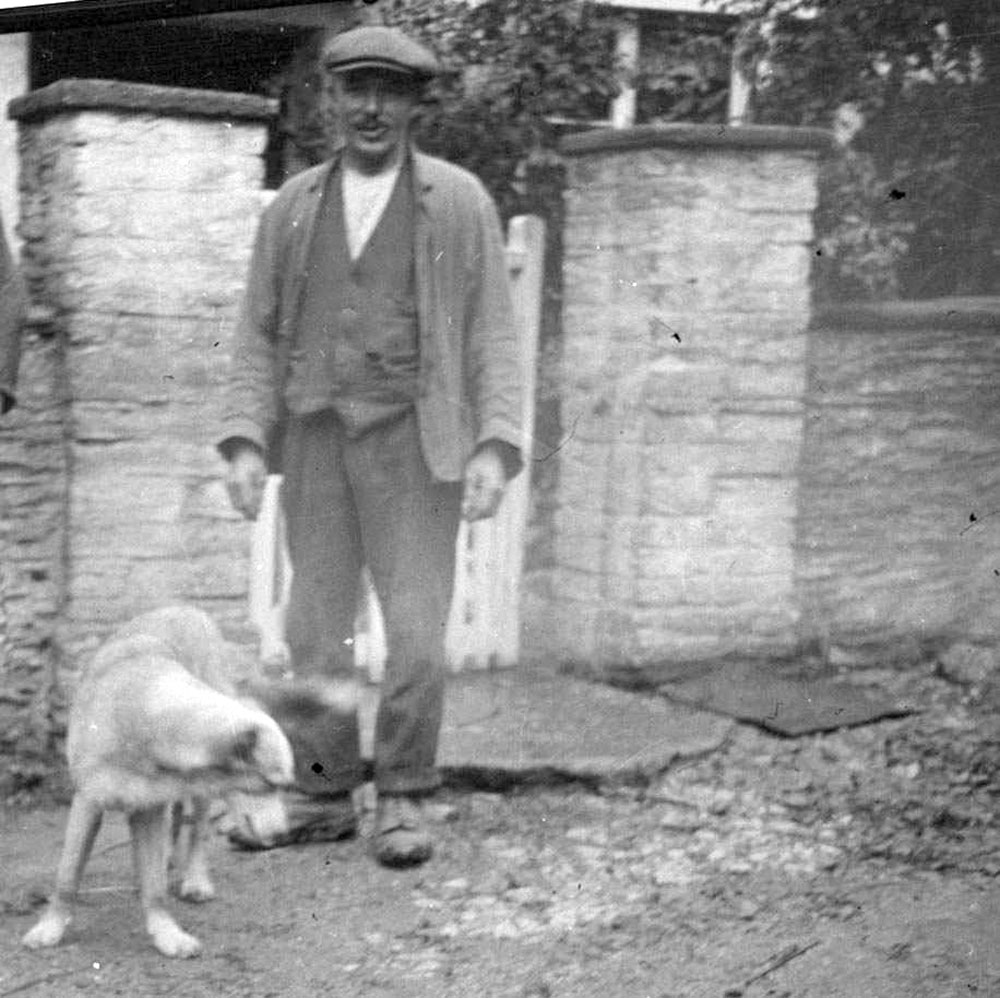 Previous occupants may
have included
the family of G. H. Nunn
who sold his stock there in 1924 at the time of his
retirement. Later an elderly gentleman named
Foale is reported
to have died there in 1929. The
Cumming family were almost certainly
the farm's tenants, rather than owners. The evidence
of that is the fact that in December 1940 a
Mr. W. Heath
bequeathed the property to his son
Benjamin Heath,
even though the Cumming family continued to live and
farm there for the next three years. Previous occupants may
have included
the family of G. H. Nunn
who sold his stock there in 1924 at the time of his
retirement. Later an elderly gentleman named
Foale is reported
to have died there in 1929. The
Cumming family were almost certainly
the farm's tenants, rather than owners. The evidence
of that is the fact that in December 1940 a
Mr. W. Heath
bequeathed the property to his son
Benjamin Heath,
even though the Cumming family continued to live and
farm there for the next three years.
The head of the family there in the
1930s/early 1940s was Mr.
J. H. Cumming (right
- John/Jack or
James/Jim, perhaps? Contemporary references to him
and his family often show variants to the family
name, including Cumming and even Cuming).
Mr. Cumming had a small herd of South Devon
cattle, the best of which regularly won awards at
various agricultural shows, both in the immediate
area and beyond - bulls, young bulls, heifers (young
and old), cows and other categories, many of them
given names which included "Keynedon". Newspaper
reports of the time record sales of such creatures
for sums varying
.jpg) between 24 and 88 guineas
(£25 - £92).
Shows included events of more than
immediately local significance, such as the Devon
County Show and the Royal Cornwall Show at
Wadebridge. The title of the latter indicates that
Mr. Cumming was sometimes competing against H.M. The
King himself - and successfully. There was success too at the Royal
Show in Bristol. between 24 and 88 guineas
(£25 - £92).
Shows included events of more than
immediately local significance, such as the Devon
County Show and the Royal Cornwall Show at
Wadebridge. The title of the latter indicates that
Mr. Cumming was sometimes competing against H.M. The
King himself - and successfully. There was success too at the Royal
Show in Bristol.
Mrs.
Cumming
(left,
probably in 1937), was of course
mainly responsible for looking after the house and
its summer
 guests and she was much helped by her
daughter Phyllis
(right, in 1938).
There was also a son, Jim,
but he had little or no contact with those who
regularly invaded his home and there is no memory of
him. Glimpses of both siblings survive in newspaper
reports of the time: Miss Phyllis Cumming showed a
bitch at the South Pool Harriers Annual Puppy Show
at Stokenham in 1937; and Mr. J. Cumming (Jr.) was
active in livestock sales the following year. guests and she was much helped by her
daughter Phyllis
(right, in 1938).
There was also a son, Jim,
but he had little or no contact with those who
regularly invaded his home and there is no memory of
him. Glimpses of both siblings survive in newspaper
reports of the time: Miss Phyllis Cumming showed a
bitch at the South Pool Harriers Annual Puppy Show
at Stokenham in 1937; and Mr. J. Cumming (Jr.) was
active in livestock sales the following year.
|
(Graham Myers - 2001)
Keynedon Mill was a
small farmstead not far from
Kingsbridge in the South Hams area
of South Devon where Father had
previously learned from a work
colleague that the Cumming
family, who were tenant farmers
there, took in holiday guests. We as
a family of four, then - my
parents, my younger sister and I -
made our first visit there in August
1935. Later, at home, the birth of my baby brother in
April 1936 dramatically changed our
rather fixed pattern of life
until we gradually became accustomed
to the nightly howling, the rows of
drying nappies and the ever present
scent of Johnson's Baby Powder.
Life continued and there were still
family holidays to look forward to.
And so we returned to Keynedon Mill that
summer as a complete family of five
and continued to do so on three
further occasions until 1939, with a
final visit in 1941 in which I
participated for just a few days.
I
well remember the plentiful and
magnificent meals that were served
there, even in wartime, although the sanitation
remained primitive in the extreme
throughout. It was a
lengthy, day-long journey from Birmingham
by car,
long before the motorway existed,
and sometimes there was an overnight
stop at Burnham-on-Sea in Somerset.
The journey entailed passing through
the centre of every single city and
town on the route with the single
exception of Exeter which acquired
its bypass near the end of the
1930s.
This is an
image of my sister, perched on the
luggage rack of the
family Morris, during one of the two
earliest visits, with the farmhouse
in the background.
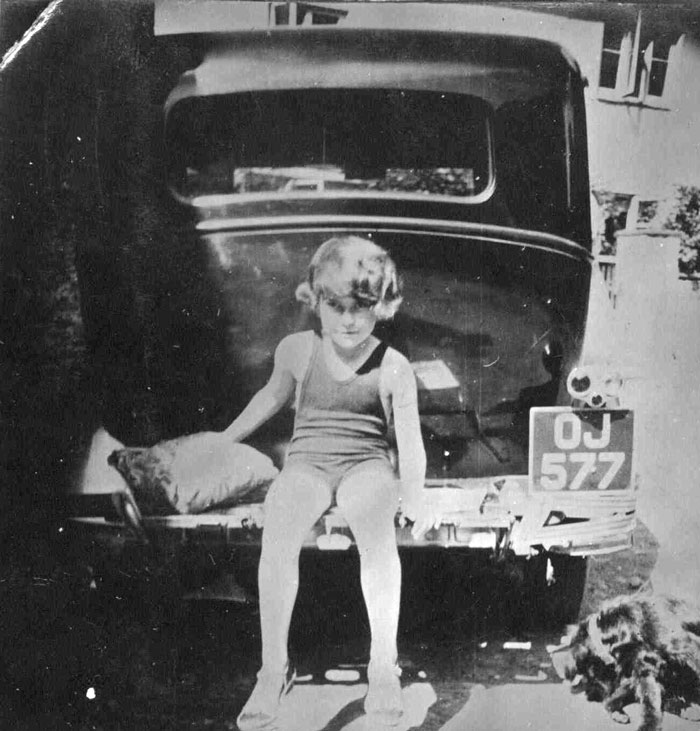
And a family group at the front
gate during my new brother's first visit,
with my mother and sister in 1936.
 |
|
Chris Myers (2025)
Whilst I remember little or nothing
of the journeys to Keynedon - I was only four
months old on the very first one
- I
retain fragmented memories of the
Cumming family, the house and farm
and the happy times we spent there,
and they no doubt relate to various
years, including the final, 1941
visit when I was five-and-a-half and
much more conscious of the world
around me. The latter visit was
memorable for a particular reason
and is also the subject of a separate
article:
Keynedon
Mill and the Evacuees - 1941
(available
shortly).
All my memories of Keynedon confirm
that it was a warm and welcoming
place, thanks to the attentions of
the Cumming family. Mr. Cumming
himself seemed to make himself
available to a surprising extent,
considering the demands of running a
farm. Well before the time when I
started to retain memories, he
introduced me to the farm horse –
whose name I do not recall – for my
second, and probably last,
experience in the saddle. Here is
he, I and the horse, probably during
the 1938 visit; and, behind us, the
family Ford V8 which had brought us
all the way from South Staffordshire
and was now in its usual parking
place, guarded by the beloved Rex,
our family dog who enjoyed a
friendly relationship with Mr.
Cumming's farm dogs.

The
horse also had to endure the
attentions of my older sister who,
like all young girls, was horse-mad
and took advantage of its existence
and availability. This earlier
image, from 1936 when she was nine,
shows her examining the horse's tail
whilst I, at a few months old and
supported by an unknown hand,
tolerate my first experience on
horseback.

In this 1938 image the horse
refreshes itself after whatever
labours it has just completed. My
sister peers out from under its neck
while I look on with vague interest
and our mother supervises.

It was no doubt the same horse which
conveyed me and Mr. Cumming one day,
several years later, in the farm
cart on a memorable trip to
Frogmore. He must have kindly made
the suggestion, my parents approved
and then, off we trundled up the
lane, with me perched up on high at
his side. What an adventure for a
young boy! We reached Frogmore and
carried on right to the top of the
hill through the village. An
unoccupied, thatched cottage was
positioned in the fork between the
main road and a track going off up
to the right. I had noticed it on
previous occasions and it had always
fascinated me because it seemed to
have been built to fit – like a
wedge of cheese or a slice of cake,
as I always saw it. Here it is,
photographed in 1936 with a smart,
contemporary Rover parked in front
of it. But now, in 1939 or 1941, the cottage was
unoccupied and looked forlorn, even
almost derelict.
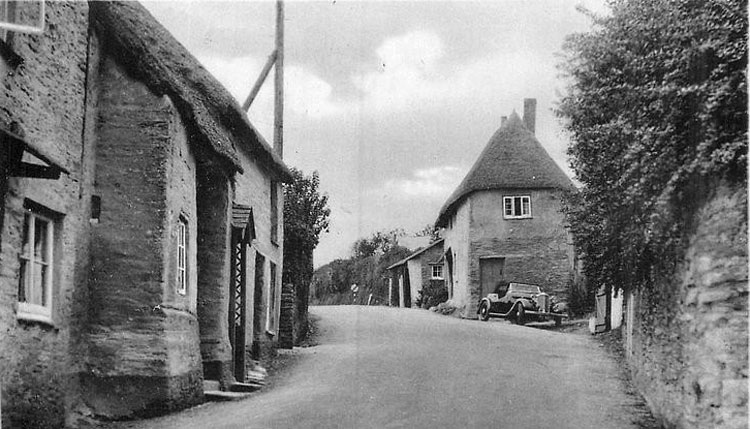
We turned on to the track
and stopped. The cart contained some
sort of load, perhaps timber or
other farm material. It seemed that
Mr. Cumming had access to the
cottage or perhaps an outbuilding
attached to it and was using it for
storage purposes. He jumped down,
opened up a door and carried his
stuff inside. Then, job done and off
back to the Farm.
The journey
back down the hill and then along
the lane towards Sherford always
stuck in my mind, for a couple of
reasons. At some point Mr. Cumming
delved into his pocket, pulled out a
rosy apple, gave it a quick polish
on his trousers and then handed it
to me. It was a surprise and I was
struck by this tiny act of kindness.
Never before or since has an apple
tasted so good! And then the horse
decided to perform its natural
function and one of its droppings
remained on a cross-piece at the
front of the cart for the rest of
the journey, to my considerable
interest. I watched it closely as we
trundled on. It wasn't a really
unpleasant object and it remained a
source of fascination even after it
had finished steaming and until I was
eventually lifted off, down from the
cart, and then committed the
lingering relic of the expedition to
memory.
(This particular detail from
one’s life experience is something
which has been retained for
eighty-five years whilst
other, rather more significant ones are
lost for ever....... such are the
quirks of memory!)
|
|
|
LIFE AT
KEYNEDON MILL
|
(Graham Myers - 2001)
In the pre-war days, we
had use of and ate our meals in the
large room to the right of the front
door as you entered the building.
There was a large old-fashioned
kitchen range, which bore the
embossed name of some craftsman in
Kingsbridge. The fire seemed to be
continuously burning, even in
midsummer, as all the cooking was
done here, as was the
cream-scalding, and a large black
kettle simmered all day long. The
beast also provided hot water, I
believe from an internal boiler
which had to be filled from time to
time, and there was a large tap
lower down which was used to draw
off the water. The Cumming family
had their meals in a smaller room to
the left but this may well have
changed by 1941.
Behind
the room to the right was a
stone-lined dairy/pantry, where
Phyllis did all her cookery
preparation work. She was a
wonderful cook, and I still remember
her ultra-light steamed jam sponge
puddings, as well as many other
delicious speciality items she
produced.
I well
remember the sanitary arrangements
for the farm: the single-seater
earth closet, situated behind the
house, and reached by means of a few
steps up the lane towards Sherford,
then turning left up the hedgerow
bank to where the edifice stood. I
did not enjoy my own visits there,
and Mother invariably took with her
a large can of Jeyes' carbolic
powder. This did little to remove
the stench, and nothing to deter the
swarms of flies, against which the
only defence in those days was the
hanging, sticky flypaper - quite
impracticable in that location!
Night visitations were usually
unnecessary, as we all had indoor
potties - strictly for Number Ones
only! The primitive sanitation was
matched by the night-time
illumination provided - several oil
lamps, supplemented by lots of
candles downstairs, and more candles
to take us up to bed. These things
were less of a hardship than might
be imagined: we were all accustomed
to the fact that available
facilities differed between rural
and urban areas, and indeed,
continued even into the post-war
period. By the late 1950s, most outlying
properties had mains electricity,
whilst proper drainage, or at least
efficient septic tanks, were in
position a few years before that.
Beyond
the way up to the earth closet,
there was another pathway up through
the bank, and through the gate one
could get into the garden. Here
Phyllis grew the vegetables for the
family, and I used to go up there to
pick runner beans, which were about
all that was available in late
August, the peas having finished by
then. Beyond this was a meadow where
the farm horse lived when not
working. The mill wheel was
certainly still in situ and I must
say that, so far as I recall, was
still there at the time of our visit
there for cream tea with Mother in
1991. I have probably mentioned that visit before, and
of how interested the then occupiers
were to hear something of how
foreigners from the big cities used
to spend holidays there in the
far-off days before the war. On the
wall were a couple of framed
pictures of the Mill in former days,
which I photographed at the time
(see
below).
Keynedon seemed to survive without
the existence of wireless. At that
time, in areas where no mains
electricity existed, the standard
radio receiver needed no less than
three batteries, one High Tension,
90-volts, a hefty item measuring
about nine by six by three inches; a
low voltage accumulator, there were
usually two of these, one in use,
whilst the other one was in the
local garage or electrical shop
where a recharging service was
available. The third battery was a
small 9-volt dry battery, known as a
Grid Bias. One final item was
required to make all this work: a
decent transmitter not too far away.
There had been a low-power repeater
station in Plymouth from the
earliest days, but its range was
very small. The new West Regional
transmitter at Start Point came into
operation only in mid-1939, but I
never saw any kind of radio receiver
installed at Keynedon, unless of
course there was a set tucked away
elsewhere in the house and
unavailable to us. I fancy Father
had to manage without his news
bulletins, and rely on the Daily
Mirror which seemed to be the
standard publication available
there.
The
harvest was a great fun day, with
the old horse-drawn reaper-binder -
I never saw a tractor at Keynedon -
sheaves gathered into stooks, and
later into ricks. As the corn was
cut, the uncut area gradually
shrank, and rabbits would dash for
cover in the hedgerows surrounding
the field. This was a dangerous
time, as everyone seemed to be
letting fly with shotguns, and even
I had a small .22 rifle and bagged
one or two victims. Dogs ran
everywhere, and just how it was that
neither man nor beast ever got shot,
I couldn't understand. This is a
glimpse of one of the Keynedon farm
dogs spotting their next victim and setting
off away from us and across the
stubble.
There was
lots of cider available, and the
weather was always warm and sunny:
no doubt it had to be before the age
of combine harvester machines. Another great interest was the
cream-making: all the yield from the
dairy herd (six or eight cows in
all) was promptly tipped into the
Alfa-Laval separator. This was a
large cast-iron affair, with a big
circular hand-wheel, and fitted with
a loud clanging bell. The device
worked by a centrifugal process, and
the art was to coax the thing into
motion, then keep it running at
exactly the right number of
revolutions-per-minute as otherwise
the bell would ring and one would be
in trouble. If everything went well,
the cream emerged from one long
aluminium spout, and was collected
in one of those large flat metal
pans ready for scalding on the
kitchen range; the skimmed milk came
from the other spout, and was
collected in a bucket. This would be
used to feed the calves, and the
cats would gather round also.
Heath's
farm (Keynedon Barton) lay down a
track a few yards along the lane in
the direction of Frogmore - slightly
mysterious, and displaying little
sign of activity.
I used to roam their fields with
Father at around dusk, he with a
12-bore shotgun and I with the .22
rifle; we usually returned with a
rabbit or two for the table.
 |
Here Father sets out
on a sunny evening in
1937 on one of those hunting
expeditions, seemingly well-dressed
for the occasion in jacket and
possibly even
a tie. Perhaps he has
only just got up from the supper
table.
(Graham is behind the cine
camera before handing it to
our mother and joining the
expedition). |
 |
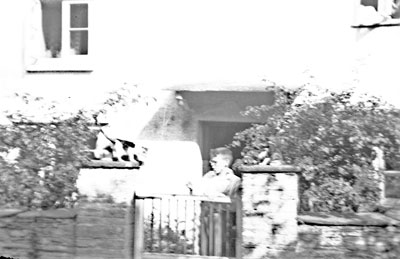 I
can remember three farm dogs:
especially Bob, and there were also
Spot and Watchful. There were
numerous cats, mostly of the
tortoiseshell and white variety, and
most of them related to one another.
At the nightly locking-up time, Mrs.
Cumming would chase them all out of
the house with hissing noises and by
rattling her long stick under all
the chairs. Here is one of them
perched on the gatepost in 1935 or 1936, in
dialogue with me. I
can remember three farm dogs:
especially Bob, and there were also
Spot and Watchful. There were
numerous cats, mostly of the
tortoiseshell and white variety, and
most of them related to one another.
At the nightly locking-up time, Mrs.
Cumming would chase them all out of
the house with hissing noises and by
rattling her long stick under all
the chairs. Here is one of them
perched on the gatepost in 1935 or 1936, in
dialogue with me.
I
also remember the farm horse, and once
accompanied Mr. Cumming on the cart
to the market at Kingsbridge and
back. As can be imagined, the round
trip took a long time. Fortunately,
the weather was fine. Surely this
cannot be the farewell party, human
and canine, seeing us off on this
adventure, as the farm vehicle
trundles off down the lane towards
Heath's Farm and Frogmore? Almost
certainly not; but for some reason
it was for Dad a moment worth
recording and it's now something for
us to try and interpret almost 90
years later.
 |
|
Chris Myers (2025)
In the later years - it may have
been only for the final visit to
Keynedon, but it is all I remember
with certainty -
we had a sitting/dining room within the
farmhouse reached by a corridor. I
still recall this room as being
quite small but it accommodated us
adequately and we had our meals
there. I feel that it was located to
the left of the front door as one
entered the house. From my brother's
recollection this cannot always have
been our base within the
house and I suspect that it was for
the final holiday only. I remember
Phyllis, the jolly daughter of the
family, bringing into this room
wonderful food - which seemed even
more wonderful at a time of ever
tighter wartime rationing - as we sat around the table;
she normally used a large wooden
tray with an inset ceramic base
(orange, I think). When it was being
taken away empty one day by Phyllis,
I took it into my head to give its
underneath a good hard knock with my
hand. The ceramic base was obviously
cracked with the result that it
erupted into the air in many pieces
before scattering over the floor. I
don't remember if I was upset about
this unexpected outcome although I
remember rather wishing it had not
happened. To my surprise Phyllis did
not seem cross - perhaps she enjoyed
jigsaw puzzles - and I think I
somehow escaped punishment.
 Almost
all other memory of the interior of
the house house has been lost. I
imagine I must have shared my
parents' bedroom, almost certainly
the room with a window located on
the right of the house as you face
it - and out of which my mother is
looking at us on one occasion. Almost
all other memory of the interior of
the house house has been lost. I
imagine I must have shared my
parents' bedroom, almost certainly
the room with a window located on
the right of the house as you face
it - and out of which my mother is
looking at us on one occasion.
I have the dimmest recollection
of once being taken into the working
part of the mill but all I can see
in my mind's eye is a large area
somewhere at the rear of the house
and an impression of old, dusty
floorboards and of general
abandonment and disuse. To my regret
there is no recollection of the
machinery which must have been still
there and had been powered by the
huge waterwheel outside - which I do
remember so clearly.
My
recollection of the toilet
arrangements is exactly as Graham
described them, but as a young child
I was spared the ordeal of having to
use them (apart from an illicit
visit with disastrous consequences
in 1941 which I have described
elsewhere). If this were the only
w.c. the farm possessed, I cannot
see how the family could tolerate
such inconvenience, summer and
winter, and they must have had more
convenient access, perhaps out of the
back of the house from kitchen or
scullery. I do not know and clearly
the arrangement for summer guests
left a lasting mark on older members
of my own family!
Whilst I
cannot recall specific images, the
lack of sanitation and any sort of
bathroom was almost
certainly matched by a lack of
electricity, illumination being
provided by oil lamp and guttering
candle. This would not have impinged on my life
as much as it would no doubt have
done on
my parents: they who had by then enjoyed
the luxury of an electricity supply
for ten years or more in their
suburban home and exploited
it to the full by the use of such
mind-boggling modern inventions as a
toaster, a copper electric kettle,
(although both these wonders had
long since ceased to work by the
time I became aware of their
existence - and when replacing them
was an impossibility), a Hoover, an electric fire,
a mains-powered Zenith wireless set
and a vast American refrigerator,
all of which did still work until
long into the postwar years. The
lack of electricity would have been of little
surprise to me. One still
encountered many such homes: in the
towns the alternative would have
been illumination by gas mantle and
out in the country, the oil lamp and
candle. And in all such cases,
wireless powered by means of an
accumulator which had to be taken to
be recharged at regular intervals;
and a very large and expensive
dry battery which in those
pre-transistor days must have
expired with depressing regularity.
At Keynedon in August, I must have
normally been in bed by dusk and so
this is probably why little memory
of these "deprivations" remains. Nor does it of the
lack of radio - "wireless" as it was
then called - although I cannot
imagine my father allowing himself
to be cut off from news,
particularly in the summers of 1939
and 1941. And anyway, I had my
personal potty and, from other
experience, was quite accustomed to
washing with the help of a
wash-stand in the corner of the
bedroom on which stood a ewer of
cold water and a large basin. As for
the weekly bath, I have no
recollection - it must have been a
galvanized tub; or perhaps my
regular immersion in the sea was
deemed sufficient to serve the
interests of personal hygiene!
I have said that I
remember the outside lavatory and
the waterwheel as adjacent. They may
have been or they may just have been
at different locations somewhere
around the back of the house. I
recall the wheel very well. It was
described to me as a highly
dangerous piece of equipment and
this is probably why I recall it as
dark, dank and forbidding. It was
not working by that time, I believe,
and it might already have been
becoming derelict. There was plenty
of dark water in the pit below the
wheel, into which a small boy most
certainly did not wish to fall; I
think there was the sound of
continually running water but apart
from that and the pond which I
mention below, one did not have the
impression of the presence of
significant quantities of water
which one might have expected,
knowing the function of the mill.
It was probably adjoining the
same meadow that there was a large
(or so it seemed to me) pond fed by
a small stream which in turn
disappeared away on the far side of
the pond into undergrowth and
woodland.
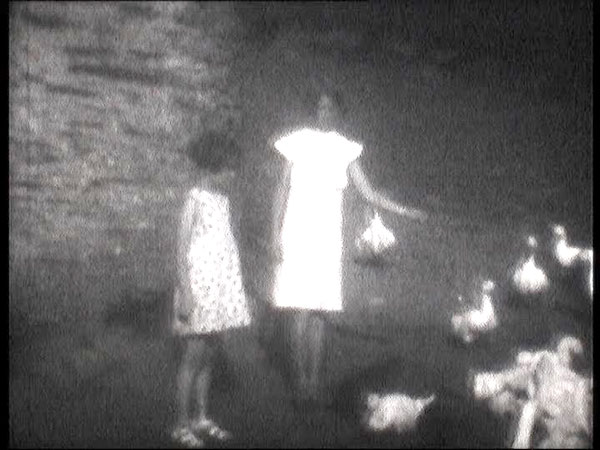 The normal route to this
area was via the farmyard at the
side/back of the house, to the left
as one faces the front, thronged
with chickens and ducks. Here is
part of the flock, being surveyed by
my mother and sister in 1937. They
are no doubt the ancestors of those
with whom I was to have a
well-remembered encounter four years
later. As one
emerged from the farmyard towards
the fields beyond, the pool seemed
to be located to the left with the
grassy area to the right. This pond
and its outlet appeared to be a
relatively gentle affair, or at
least at that time of the year, and
was of course downstream of the
waterwheel. One day I floated my
bath-time boats on this (including a
wooden "Graf Spee" battleship which
was regularly sunk in my bath at
home long
before a similar fate overtook the
prototype; and I believe, a
Cunarder, MV “Britannic”, on which
my father crossed the Atlantic in
1935 or 1938). To my utmost horror
and panic the boats drifted across
the pond in the gentle current, away
from me and towards its outlet, and
then disappeared beyond it, never, I
felt, to be seen again. Screams and
hysterics resulted in Dad somehow
finding a way to the far side where
the boats were retrieved from the
little stream beyond and I was
calmed down. The normal route to this
area was via the farmyard at the
side/back of the house, to the left
as one faces the front, thronged
with chickens and ducks. Here is
part of the flock, being surveyed by
my mother and sister in 1937. They
are no doubt the ancestors of those
with whom I was to have a
well-remembered encounter four years
later. As one
emerged from the farmyard towards
the fields beyond, the pool seemed
to be located to the left with the
grassy area to the right. This pond
and its outlet appeared to be a
relatively gentle affair, or at
least at that time of the year, and
was of course downstream of the
waterwheel. One day I floated my
bath-time boats on this (including a
wooden "Graf Spee" battleship which
was regularly sunk in my bath at
home long
before a similar fate overtook the
prototype; and I believe, a
Cunarder, MV “Britannic”, on which
my father crossed the Atlantic in
1935 or 1938). To my utmost horror
and panic the boats drifted across
the pond in the gentle current, away
from me and towards its outlet, and
then disappeared beyond it, never, I
felt, to be seen again. Screams and
hysterics resulted in Dad somehow
finding a way to the far side where
the boats were retrieved from the
little stream beyond and I was
calmed down.
|
|
HOLIDAYMAKING
|
(Graham Myers - 2001)
The period of the family's stays
at Keynedon, during August, included
the corn harvest, the Dartmouth
Regatta, rabbit shooting, and
earlier nightfall which moved from
8.30pm to about 8pm whilst we were
there.
Dartmouth
Regatta took place (and still does)
each year at the end of August. We
usually spent an afternoon and
evening in the town, a well-filled
picnic basket having
 been provided
by Phyllis. Sometimes she would come
along with us. been provided
by Phyllis. Sometimes she would come
along with us.
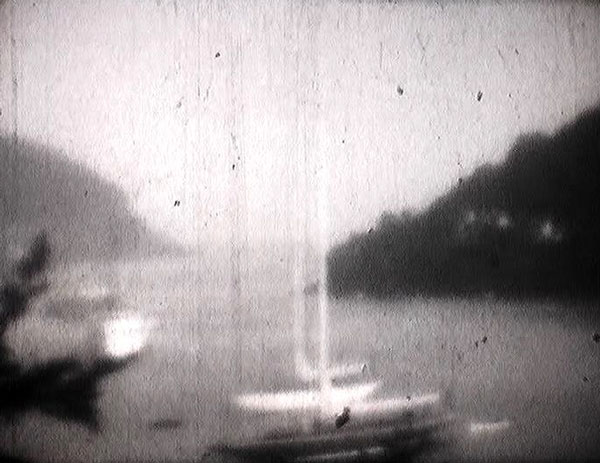 There were sailing
events to observe, but these were
only of passing interest; I was much
more taken with the funfair and
side-shows arranged in the riverside
gardens, where there was also
open-air country dancing which
Father seemed to enjoy - he was
always an accomplished and
enthusiastic dancer. As darkness
fell, the area would be illuminated
with strings of coloured Chinese
lanterns, each containing its
lighted candle: obviously this was
before the days of modern fairground
lighting methods - or of amplified
recorded music! There were sailing
events to observe, but these were
only of passing interest; I was much
more taken with the funfair and
side-shows arranged in the riverside
gardens, where there was also
open-air country dancing which
Father seemed to enjoy - he was
always an accomplished and
enthusiastic dancer. As darkness
fell, the area would be illuminated
with strings of coloured Chinese
lanterns, each containing its
lighted candle: obviously this was
before the days of modern fairground
lighting methods - or of amplified
recorded music!
For visits
to the beach, Lannacombe became a
favourite. It was a year or two
after our first visit that Father
found this place; it was awkward of
access, being about a mile from the
road, reached by means of a very
narrow and rough track, much
improved nowadays. The great
attraction was that it possessed the
only proper sandy beach in the whole
district. The only other one
anything like it was Blackpool
Sands, near Stoke Fleming, but here
the sand was more gritty in texture.
|
|
Chris Myers (2025)
I, too, retain much in my mind's eye
of the new experiences provided by
our weeks at Keynedon over several
years as I learnt the joys of being
on holiday, some just fleeting
glimpses, others more detailed and
clearer .....
..... of
harvesting, in which my father used
to participate with his usual
enthusiasm and energy and a single
memento of which, a labourer’s
small, wooden cider barrel, perhaps
from a slightly earlier age, adorned
the family home from as long ago as
I could remember and must still
exist somewhere in the family;
..... of the
working blacksmith in a village
adjacent to Frogmore to which we
could walk, with its hammering of
red hot iron, sizzling noises as the
shoe was applied to the horse’s hoof
and the smell of singeing before the
nails were hammered in; and of one
of the blacksmith's customers, the farm’s
friendly carthorse;
..... of Bob the sheepdog, a
vast and amiable creature with which
I was permitted to play without
subsequent mishap;

.....
of my swinging on
the front gate, a most enjoyable and
regular exercise;
..... of Heath's farm next
door, mysterious and located off
down a track which I never
entered;
..... of walks along narrow,
leafy lanes and over field and
pasture, and here we are,
my mother, sister, brother and me, at the house gate, just setting out
on one of them:

..... of riding with Mr.
Cumming on his horse-drawn cart.
..... and, of course, most
wonderful of all, the seaside, at Lannacombe, East Portlemouth,
Torcross and elsewhere.
I
cannot recall visiting Blackpool
Sands in those years. It did not
seem to be a favoured destination.
Lannacombe was however a different
matter and a regular treat. At a
time before I ever recall seeing it,
my sister would regale me at home
with tales of the wonderful sand
and, especially, the narrowness of
the lane to it,
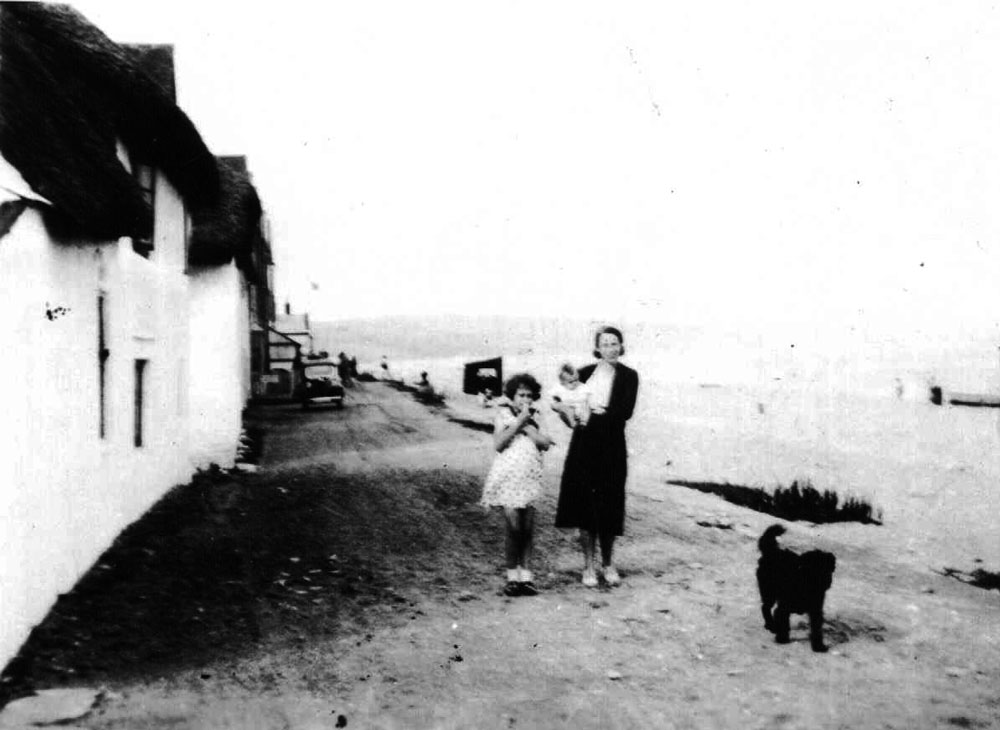 so narrow that the
grass would swish along both sides
of the car. Thereafter I would wait
in vain for this phenomenon to occur
whenever we visited and I suspect
that a little lane widening - or
perhaps just grass trimming - had
occurred by the time of my
consciousness. so narrow that the
grass would swish along both sides
of the car. Thereafter I would wait
in vain for this phenomenon to occur
whenever we visited and I suspect
that a little lane widening - or
perhaps just grass trimming - had
occurred by the time of my
consciousness.
Another favoured destination was
East Portlemouth, on the side of the
estuary opposite Salcombe and some
images survive of more than
one happy
day spent there.
Torcross was also a regular
destination, despite the limitations
of a shingle beach. It had been the
place of perhaps my very first sight
of the sea, as a baby-in-arms in
August 1936, carried by my mother in
a
small family group walking towards the
camera.
(I have made an
 interpretation of the
moment preserved in that photograph
- and its sequel of nine years later
- in a separate article,
Torcross - 1936 and 1945). interpretation of the
moment preserved in that photograph
- and its sequel of nine years later
- in a separate article,
Torcross - 1936 and 1945).
Just as in previous years Dartmouth
was a regular place to visit -
perhaps once during each holiday. I
don't recall the Regatta, though:
perhaps I was deemed too young to
attend, especially in the evening,
and by 1941 it would have
disappeared
anyway and, with it, all the
beautiful leisure craft.
 Images survive of harvesting at
Keynedon in a cine film taken by my
father in 1937 or 1938 and I
remember such events, possibly
from 1941 and most definitely from
other farm visits, nearer home, later in the war
-
and also into the immediate postwar years
at a farm at Beeson, only a couple of miles
away from Keynedon. Images survive of harvesting at
Keynedon in a cine film taken by my
father in 1937 or 1938 and I
remember such events, possibly
from 1941 and most definitely from
other farm visits, nearer home, later in the war
-
and also into the immediate postwar years
at a farm at Beeson, only a couple of miles
away from Keynedon.
 The one of which we have glimpses
here from the cine film shows a tractor, contrary to
my brother's recollection. But it
would certainly not have belonged to
Keynedon Mill and would have been
the equipment of a contractor or
even a friendly neighbour such
as the Heath family. The
overwhelming recollection from those
days was the busy, clattering binder being
towed around the field by
the loyal farm horse. The one of which we have glimpses
here from the cine film shows a tractor, contrary to
my brother's recollection. But it
would certainly not have belonged to
Keynedon Mill and would have been
the equipment of a contractor or
even a friendly neighbour such
as the Heath family. The
overwhelming recollection from those
days was the busy, clattering binder being
towed around the field by
the loyal farm horse.
My father, ever energetic,
enthusiastic and anxious to help,
gets involved.
He moves backwards and
forwards, moving sheaves and
creating stooks in one of Keynedon
Mill's fields, all against a
background of beautiful
South Hams countryside
and, beyond, the nearby shimmering sea.
The thrill of the chase was
overwhelming and a young boy gave
thought neither to the dangers of
the binder and the several firearms
being used all around him, nor to
the desperation of the creatures
which found their habitat getting
smaller and smaller as the machinery
and its accompanying hordes of
murdering humans and dogs approached
ever nearer. We can't see the
shotguns nor hear their crack; but
we have already seen, in Graham's
note above, one of the farm dogs
joining in the fun.
 Similarly with the rabbiting
in an evening over the farm's
fields. I was too young at Keynedon
but my father took me a year or two
later, just as he had done my elder
brother at Keynedon, over wartime
Herefordshire fields and later,
after our return to the South Hams
in 1945, over fields so similar to
those which Mr. Cumming had farmed. Similarly with the rabbiting
in an evening over the farm's
fields. I was too young at Keynedon
but my father took me a year or two
later, just as he had done my elder
brother at Keynedon, over wartime
Herefordshire fields and later,
after our return to the South Hams
in 1945, over fields so similar to
those which Mr. Cumming had farmed.
The pleasure of chasing, catching and
despatching, or of merely stalking and
trying to shoot, was something which
gradually, as one grew up, faded
until it was eventually overwhelmed
by the adult townie's over-developed
sensitivities and disappeared
entirely, except in the memory.
We saw the aftermath of the
harvesting after all the hard work
and excitement had come to an end,
and one of the aims of the activity
achieved
- my mother and sister
(right)
pose in front of a newly created
rick in the farmyard. The harvest
has been safely gathered in.
Although I was
barely aware of the
fact at the time, my sister, Sheila,
had a well-loved playmate during her
holidays at Keynedon. There was a
cousin of the Cumming family
 who
lived in Frogmore by the name of
Beryl Moore. This is she,
seen enjoying a sunny day out with
our family in 1938, on the left of
the photograph and sitting next to her
cousin Phyllis Cumming on the beach
at East Portlemouth. By the time
that I became fully conscious of her
existence, and when we used to visit
her after the war, she lived with
her widowed father in a house on the
right-hand side of the road up
through the village, about halfway
up, nearly at the top. A delicious
cream tea there one afternoon during
our holiday was to become an annual
tradition in the post-war years -
home-made gooseberry and raspberry
jam and Devonshire cream, scones and
delicious cake, mostly no doubt
created at least in part with raw materials from Mr.
Moore's lush garden on the other
side of the road and with the help
of a large, paraffin-powered cooking
range. I remember Beryl fondly as
a sweet, uncomplicated and gentle
girl. who
lived in Frogmore by the name of
Beryl Moore. This is she,
seen enjoying a sunny day out with
our family in 1938, on the left of
the photograph and sitting next to her
cousin Phyllis Cumming on the beach
at East Portlemouth. By the time
that I became fully conscious of her
existence, and when we used to visit
her after the war, she lived with
her widowed father in a house on the
right-hand side of the road up
through the village, about halfway
up, nearly at the top. A delicious
cream tea there one afternoon during
our holiday was to become an annual
tradition in the post-war years -
home-made gooseberry and raspberry
jam and Devonshire cream, scones and
delicious cake, mostly no doubt
created at least in part with raw materials from Mr.
Moore's lush garden on the other
side of the road and with the help
of a large, paraffin-powered cooking
range. I remember Beryl fondly as
a sweet, uncomplicated and gentle
girl.
|
|
HAPPY DAYS ON THE BEACH -
1938

Sheila,
Graham, our mother Freda, Chris and Rex
(East Portlemouth)

Rex, Freda, Sheila,
Chris
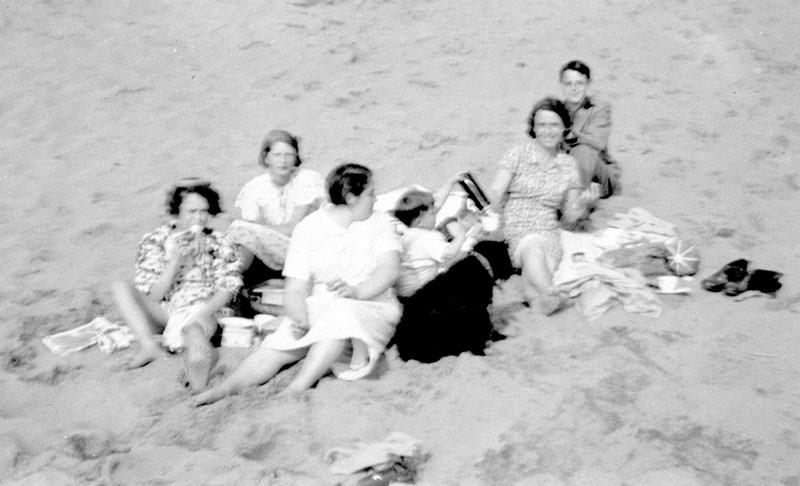
Sheila, her
friend Beryl, Phyllis Cumming, Chris,
Freda, Graham
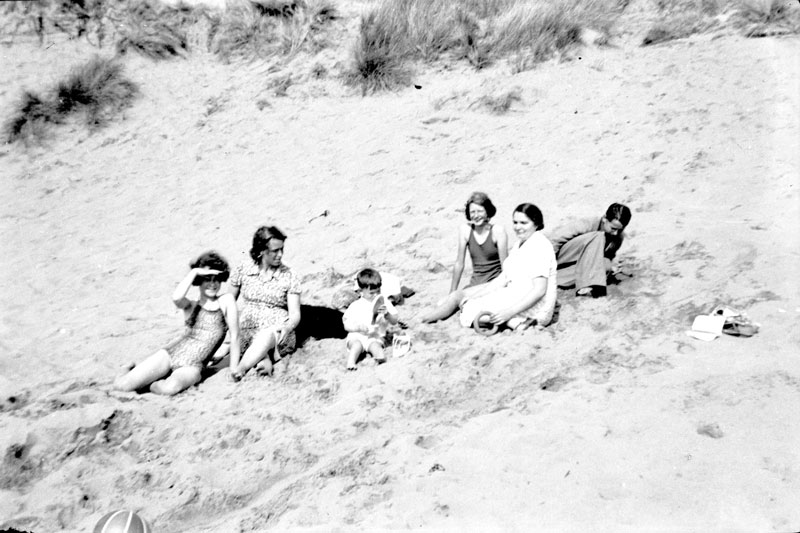
Sheila,
Freda, Chris, Beryl, Phyllis, Graham
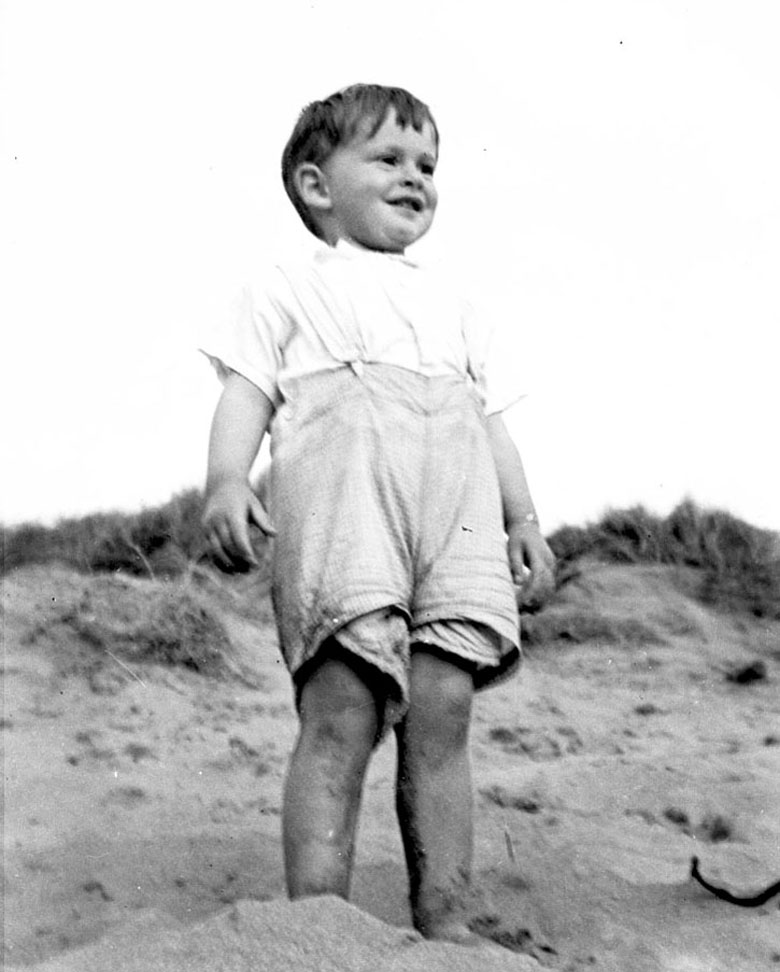
And
at Bantham Chris surveys the wonders of the seaside
|
THE 1941 HOLIDAY
(Graham
Myers - 2001)
In 1941, we paid our final visit to
the farm at Keynedon Mill. Father
and I travelled down from Birmingham
to Kingsbridge by train. The rest of
the family had been there already
for a while when we arrived, late at
night, having had to walk most of
the six miles there from
Kingsbridge. The stay was enjoyable,
with plenty still to eat, and all
too soon we had to return home.
(Graham recorded little further of
his final, 1941 visit, apart from
noting that, in contrast to the
recollection of his younger brother,
he was not conscious
of the presence of evacuees on the
farm. It was of course a
fleeting visit, of just a few days,
after which he and the rest of the
family returned to Birmingham, and
reality, by train. Not long
afterwards his own life changed
utterly and more significant
experiences superseded those of
normal family life .......) |
|
Chris Myers (2025)
As Graham
said, we had our final holiday at
Keynedon Mill in August 1941,
although we had no idea it would be
the last and, almost certainly,
neither did the Cumming family. I
have further memories of that visit,
over and above those I relate here,
and these are the subject of a separate
article,
Keynedon
Mill and the Evacuees - 1941
(to
follow shortly).
And I have described, above, the
memorable trip to Frogmore Mr.
Cumming so kindly gave me that year
in his farm cart, with me perched up
aloft at his side.
At some time
earlier in the summer of 1941 my father must
have considered that the
international situation had eased
somewhat. The country had been
standing alone for over a year after the almost
total occupation of Europe by the
Germans, with the USA remaining
officially uncommitted to the struggle against
Nazism. But in some ways things were
less threatening than they had been
12 months previously: aerial attacks
on the country had reduced, Hitler's
attention was now concentrated
eastwards with his planned
invasion of the Soviet Union in June
and the ongoing conflict in North
Africa; as a result the
likelihood of invasion of this
country had - for the time being and
for as long as the Russians could
hold out - significantly
reduced. Moreover, whilst petrol for
private use was severely rationed,
leisure motoring had not yet been
entirely banned as it would be in
the near future. And so he decided,
quite remarkably, that a family
holiday was feasible and started to
collect his petrol coupons. How
lucky we were to have a holiday at
that time!
We must
have travelled to Devon in the
family's Ford Prefect, purchased the
previous year during the period of
the Phoney War to replace the rather
more thirsty Ford V8 as the prospect
of desperate petrol shortages
loomed. Just the four of us - my
brother was working. But I have no recollection
of the journey on those roads with
their dreaded military convoys,
trundling along at frustratingly low
speeds. Just perhaps the odd,
exciting glimpse of aerodromes, with
camouflaged Spitfires and Hurricanes
and Defiants dispersed around the
perimeter, safe under their
individual, curved shelters of
corrugated iron whilst RAF men
worked on them. Often the aircraft
were only just the other side of the
barbed wire which separated them
from the nearby road - what
excitement they gave a five-year-old
boy! But of course, stopping in
order to look was strictly
prohibited and Dad was never
persuaded even to try.
One day, we ventured into
Plymouth by train from Kingsbridge.
This was only a few months after the
two worst air-raids there, in March
and April 1941. I have a memory of
the train halting on the outskirts
for a few minutes when the
impression I had was of a flat,
desolate area with buildings in the
distance; but whether this was
evidence of the devastation, I do
not know. As we walked around what
had been the centre, entire shops
seemed to have been replaced by
single-storey wooden structures with
whatever goods they were able to
offer being displayed behind small
glass windows set into blank,
plywood walls. Since
the previous winter and this year's spring,
some of the sights
must have been familiar to my
parents with their experience of the
Birmingham Blitz during much the
same period; but
to me, well, they were just another
aspect of a strange world which my
five-year-old self was still
struggling to absorb and understand.
Life for
me at the farm carried on much as
usual but at some
stage Dad had to return home and I
remember waving him off at the
bridge in Frogmore as he started on
his long, lonely journey back to
Birmingham and all it had to offer -
wrecked areas of the city, tight
food rationing, unrelenting work and
worry in a factory which was
operating all hours to supply the war
effort and with what little spare
time there was entirely devoted
to Home Guard activities
and the tending of the vegetable
patch. How miserable for him those
ensuing eight or nine hours must have been
after the joys of Keynedon, long
after we had trudged back down the
lane to the farm and resumed our
holiday. Contact
was maintained by letter and
postcard and one morning I was thrilled
to receive, addressed just to me,
a small
package containing a bar of
Cadbury's Dairy Milk chocolate in
its exciting purple wrapper.
But eventually, after I do not know how
long, I was told that Dad and Graham
would be turning up very shortly.
I recall excitedly watching their arrival late at night
as they stood in the entrance
hall, blinking in the lamplight as
they were welcomed after their long
walk with luggage all the way from
Kingsbridge.
All too soon,
for us and especially for them, I
imagine, it was time for us to
return, by train from Kingsbridge to
Birmingham. What memory I have of
wartime rail journeys merge together
and I cannot identify anything
specific about that particular one.
But no doubt it would have taken for
ever, with long delays whenever we
needed to change;
and then whatever train we were on
regularly stopping and starting and
then stopping again without
explanation as more important
traffic was allowed through. Every
carriage would have been crammed, with people
squeezing into compartments or
sitting in the corridor on suitcase
or kitbag, many of them puffing on
cigarette or pipe, willing the
journey to end. And then, as dusk
approached, the blinds were pulled down
and the only lighting came from
bulbs which seemed to emit little
more than a dim glow. It must have
been a nightmare for the grown-ups
who retained memories of the
relative comforts and standard of
service of pre-war railways; but I
was small enough to be comfortable
and for me it was a constant thrill
anyway - especially if the journey
took us up the Lickey Incline in
Worcestershire and Dad and I would
then wait for
the jolt when the banking engine
joined the rear of our train. On at
least one occasion I was allowed to
pull up the blind and peer out of an
open window to see what was going
on.......
|
|
POSTSCRIPT
|
(Graham Myers - 2001)
That 1941 holiday was indeed to be
the last we spent at Keynedon Mill.
The farm and family fell victim to
the December 1943 evacuation when
the US Army took over a large area
of the South Hams centred on Slapton
Sands in order to train for the
landings on Utah Beach in Normandy
the following summer. The
pre-Normandy evacuation of the
civilian population came about,
without very much warning, towards
the end of 1943. I believe that the
final date to be clear of the
exclusion area was on or about 22nd
December of that year. At much the
same time, non-resident visitors
were banned from a wide area
including large parts of the South
Coast, and police were positioned at
strategic points such as railway
stations to intercept offenders.
According to Press reports of the
time, several people were arrested
and fined for infringement of the
regulations.
I visited the
area in December 1946 by train, shortly after
my demobilisation after
four-and-half years of Army service
spent in North Africa, Sicily, Italy
and Austria. This was part of a trip
to various places including
Launceston, where I had trained in
the Royal Artillery, and I stayed in
digs in Plymouth. I called on the
Cumming family to pick up our
Christmas dinner, and at that time
they were living in the nearby
village of Charleton. Whilst I was
there, they were threshing in the
barnyard, using traditional methods
which involved two steam traction
engines to provide the power. I can
still remember how cold it was
during those few days, just before
the ferocious winter of 1947 set in
for the next three months!
Almost 50 years after I had last set
foot inside the house, in the late summer
of 1991, I was in the area with my,
by then, 92-year-old mother, and
noticed that the owners of
Keynedon Mill were serving cream
teas. The people there were
fascinated to hear our story of
having stayed there for holidays
half-a-century before. The interior
of the house was much modernised but,
outside, things were much as I
remembered them, especially the
droves of flies which infested all
the cow sheds and other
outbuildings. This is a photograph
of the house as it was then, in
September 1991.
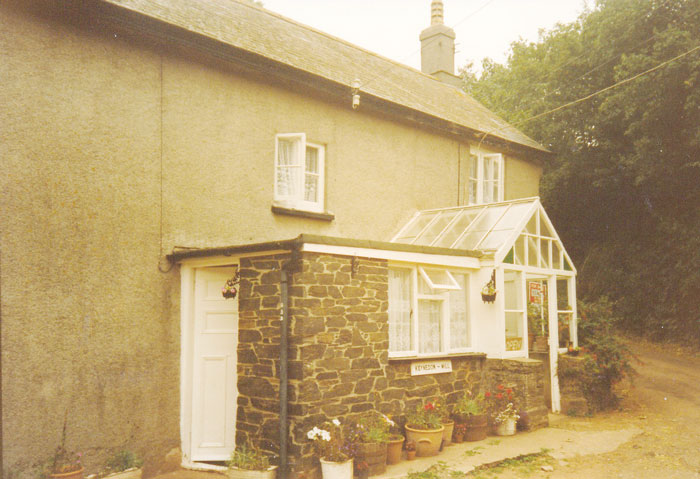
A For Sale notice lurks beyond
the porch. And on a wall inside a
couple of old framed prints show the
farmhouse as it once was. The
one on the left appears to indicate
an original thatched roof.
|
|
|
Chris Myers (2025)
We never returned to
Keynedon Mill, as my brother
confirmed. From 1943 onwards the
whole area was requisitioned as a
training ground for U.S. invasion
troops, with all the population
having to leave at short notice. The
Cumming family occupied, I believe,
a house in Frogmore, about halfway
up the road on the right-hand side
where they still were in August 1945
when we first returned to the area
after VE Day. (Graham mentions a
home in Charleton - whether they had
moved there after 1945 or whether my
memory is at fault, I don't know).
But wherever it was, all of their
stock seemed to be held in temporary
enclosures at the back of the house.
And somehow Mr. Cumming succeeded
in continuing his cattle breeding
and selling activities: a newspaper
article from October 1945 mentions
his sale of the bull "Frogmore" at
the Totnes Autumn Sale of South
Devons. Whether they were unable to
return to Keynedon Mill at that time
or whether they had already decided
not to, I do not know. But they
never did and eventually they
resumed their farming activities in
Bovey Tracey.
Throughout the war the Cumming
family had been the source of our
Christmas dinner, normally a goose,
I think. The parcel used to arrive
by post in a cardboard carton with
the dressed bird and all the
trimmings and its consumption must
have been a major event at a time
when I can still recall the thrill,
and the luxury, of the very
occasional roast chicken. One year
either the post was delayed or the
weather was particularly mild; as a
result the bird arrived in a very
ripe state and had to be immediately
buried in the garden. My parents
were kind enough not to mention this
to the Cumming and merely wrote a
letter of thanks saying how
delicious the goose had been - which
was when I learnt as a small boy
that sometimes it is acceptable to
tell a fib if it is done for the
right reasons. I assume that the
replacement for the smelly but
beautifully dressed carcase was a
black market cockerel. It seems from
Graham's comments that this
tradition persisted into the
immediate postwar years - a time of
even tighter food rationing in some
respects - and beyond Mr.
and Mrs. Cumming's departure from
Keynedon.
In the following
years, contact with the Cumming
family was maintained after their
move to Bovey Tracey, but only in a
desultory fashion and eventually,
and perhaps inevitably, it lapsed.
But my sister maintained contact
with her friend and their relative,
Beryl, and so perhaps the family
continued to hear about the fortunes
of the Cumming family. In 1948
Beryl made the long journey up to
the outskirts of Birmingham to be a
guest at my sister's wedding; she
subsequently married a man named Jim
Rudd, had a son and, I think, lived for the
rest of her life in West Charleton.
She and my sister remained friends
for some 60 years until Beryl’s
death in 1999, little more than 18
months before that of her life-long
friend and my sister, Sheila.
For me and my own family
members, life in a rural Devon
community remained a dream, an
idyll. In 1960, as my father
approached retirement, he and my
mother
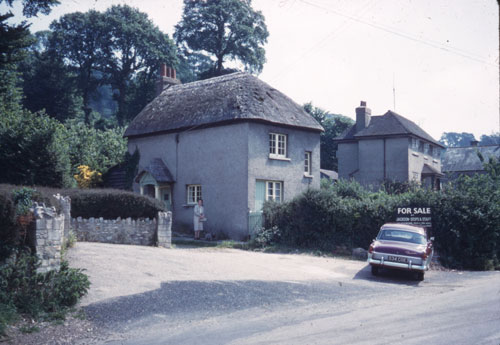 decided
to purchase their own thatched
cottage in a village further to the
east, Axmouth, near to Seaton. This
is the cottage, at the time of its
purchase. Here they regularly had
extended stays and it was of course
available to each of their own three
children and the six grandsons.
The latter included my own two
young boys and no doubt all six have
retained their own memory of Devon
life in those times. In the 1970s
ownership of the cottage transferred
to my elder brother whose permanent
home it became. Graham and his wife
lived there until his death in 2002
and Nora remained for a further
decade, continuing to enjoy a
village life which had always
fulfilled all of their hopes and
expectations. decided
to purchase their own thatched
cottage in a village further to the
east, Axmouth, near to Seaton. This
is the cottage, at the time of its
purchase. Here they regularly had
extended stays and it was of course
available to each of their own three
children and the six grandsons.
The latter included my own two
young boys and no doubt all six have
retained their own memory of Devon
life in those times. In the 1970s
ownership of the cottage transferred
to my elder brother whose permanent
home it became. Graham and his wife
lived there until his death in 2002
and Nora remained for a further
decade, continuing to enjoy a
village life which had always
fulfilled all of their hopes and
expectations.
In the many decades which
followed the family's last visit to
Keynedon in 1941, up to the fairly recent
past, I drove past the Keynedon Mill
on the few occasions when I was in
the South Hams. This photograph shows the exterior of the house in
1975, somehow diminished with the
passing of time.
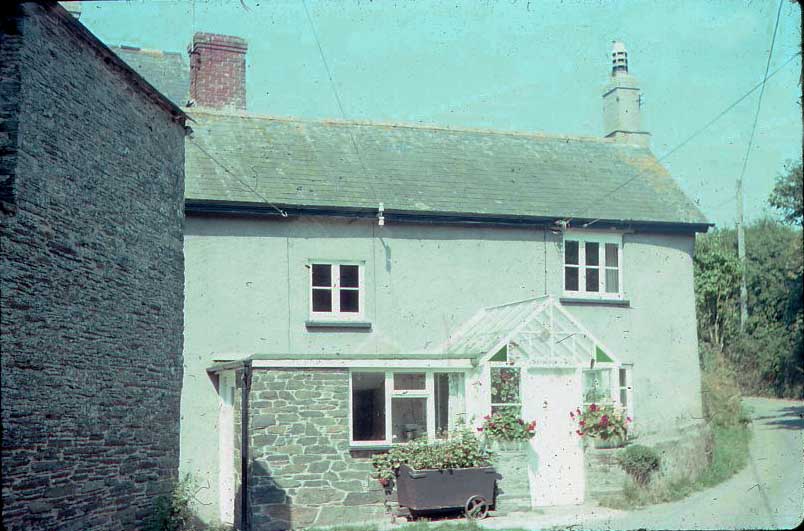
I was even cheeky enough, in
different years in the period up to about 2010, to knock on
the front door a couple of times to
speak to the then owners - but
never, to my disappointment,
succeeded in penetrating beyond it!
And so all
the surviving memories of the house and surroundings,
of the
family who occupied it, of what life
was like there and of the joy all of
it gave to one very small boy and to
his family as a whole, are
glimpses of the wholly different,
rural world of nearly 90 years ago.
That South Hams world with all its
wonders which I was lucky enough to
see and enjoy at the very beginning
of my life has
now disappeared almost without trace.
But
I remember it with affection - and with lasting regret
at its loss......
|
|
ACKNOWLEDGEMENTS
and SOURCES
With the exception of the 1936 Frogmore
image from an unknown online source, all
images which
appear on this page are part of the
Myers Family archive and belong to various family
members.
This family
and local history
page is hosted by
www.staffshomeguard.co.uk
(The Home Guard of Great Britain, 1940-1944)
All
text and images are, unless otherwise stated, © The
Myers Family 2025
Please see also:
KEYNEDON MILL AND
THE EVACUEES - 1941
FROM FROGMORE TO
KEYNEDON - 1937 |
|
INDEX
Home Guard of
Great Britain website 1940-44 |
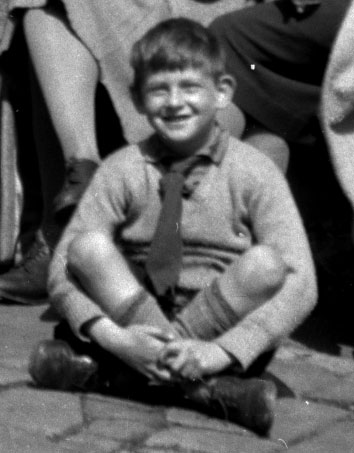 |
INDEX
Streetly and Family
Memories 1936-61
|
INDEX
Devon Memories
1936-61
|
L9B April 2025 Text and Images © The Myers Family
2025


|
|
|
|